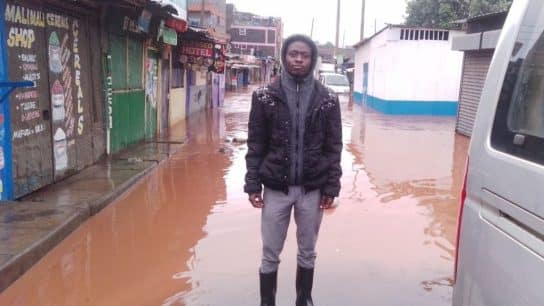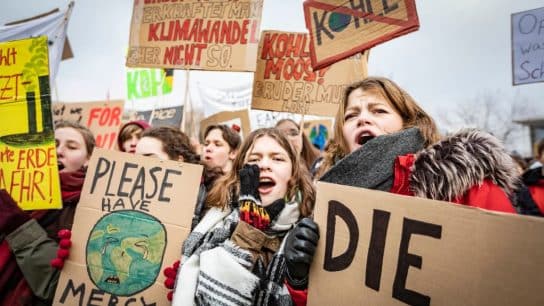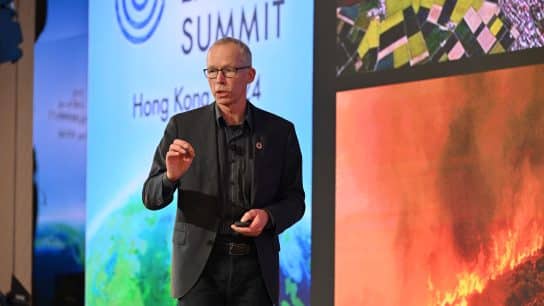At 4am on April 24, 2024, Nairobi-based environmentalist Washington Mboya was called onto scenes in his neighbourhood, which he describes as “painful” and “never seen before.” By the latest count, devastating torrential rains, floods, and landslides in Kenya have killed over 200 people since March and displaced nearly 200,000 people. 1.2 Dairies’ Jennifer Kwao spoke to Mboya in the wake of floods for a closeup look at how vulnerable communities have been impacted.
—
Jennifer Kwao: I know this week has been tough. Could you walk me through your experience of the floods and what is happening now?
Washington Mboya: Around 4:35 am on Wednesday 24 April, I received a call to come and witness what was happening in the areas around the Nairobi River. I thought it was just raining lightly – not flooding – as it has since the beginning of April. But when I went down to the Mathare River, I was really shocked. I have never seen something like it before. The river had crossed its banks and was moving really fast. The waterfall was flowing so fast and forcefully that some people were caught in the current. It was impossible to see where or what it landed on. Even vehicles were not spared.
Many people have lost everything. Those who have been farming and pig rearing along the river have lost everything. People couldn’t sleep because they were losing all their belongings. Some were missing relatives.
As soon as the water began subsiding, I saw people going back to their houses, cleaning and trying to salvage their belongings as they had nowhere else to go. I have always been critical of settlements in the riparian areas and helped educate people about the dangers of residing there. But I also know that many of these families did not have the option of living on high ground and many of them never thought they would experience such a disaster. I see shock and trauma all around.
The flood is worse in downstream areas, especially in Lucky Summer area where the rivers Mathare, Nairobi, and Ruaraka meet. We hear the devastation there is severe.
In Ruaraka and Mathare, there have been over ten deaths and countless missing. We are still trying to find out the exact number of victims in these areas. It is all really painful to witness.

Jennifer Kwao: How many days has it been since the flooding started?
Washington Mboya: It’s been nearly two weeks since the heavy rains and floods began. The heaviest came on Wednesday 24 April and last weekend. There are reports that recent violent rainfalls caused the rivers to overflow. On top of this, there are rumours that a couple of dams upstream were forcibly opened which caused a heavy flow downstream.
Jennifer Kwao: I now have a clearer picture. You mentioned shock amongst residents. Is there a warning system in place to warn people of flood risks?
Washington Mboya: I’d say early warning systems were in place but this was an extraordinary situation. Even the Kenya Red Cross is struggling to handle it.
In 2023, I was involved in a campaign to raise the awareness of communities living along the Nairobi River about flood risks. At the time, there was already high precipitation forecasted for 2024. This is a form of early warning system we have.
Overall, I feel communities ignore government-issued warnings because they are not given alternatives in terms of shelter. Where are the shelters? Where should they go? Besides that, there is very little trust in the government. But I feel this flood has caused a massive shift; people now know how the river operates, that they should not interfere with it, and that riparian areas shouldn’t be used as settlements. It’s a very hard lesson.
We just need a strict ban on settlements in the riparian areas.
More on the topic: Extreme Heat, Heavy Rain Kill Hundreds Across Thailand, East Africa
Jennifer Kwao: How has the government responded so far?
Washington Mboya: I didn’t see any government representative that Wednesday – shockingly. The community members were the main people who were helping out. They are the first to carry out rescues even without basic tools. There are many risks which is why I applaud the people’s commitment to finding a solution and rescuing victims.
On the other hand, I’ve seen the Kenyan Red Cross trying to provide shelter, medical supplies, and food. I sense that the local authorities are ashamed for turning a blind eye to settlements in the riparian areas. They might also fear the community’s outrage. I suspect they are in their offices now trying to create a task force. However, they must involve the community members in such plans since we are the ones leading the response and rescues.
Other parts of the country have also been hit by floods so the government’s resources are probably stretched and overwhelmed. They were running around in the other areas but they avoided the slums.
I don’t think they understand how big of a catastrophe this is here. For us who have been to the slums, we know the pain. Even as the water is subsiding, some houses lie in the middle of the river with families stuck on their roofs with no way out.

Jennifer Kwao: So it’s happening in several areas, but the response in the slums has been weaker or less immediate. What do you think needs to be done to prevent this in the future?
Washington Mboya: The government needs to invest in the community because as victims, we have community-minded solutions. Even if early warning systems are provided, community groups are the ones who will be doing all the real work as we see them doing now as first responders. People on the ground are ready to work but they need support.
I am currently part of a group of environmentalists called the Blue Angels. Using Monday.com, we are trying to record the number of casualties and affected areas in the slums. We are gathering this data to share with the government and other relevant stakeholders so that when they start working, they know the risk areas and the extent of the devastation in those places. There should be cooperation between communities and the government to reach marginalised areas like the slums. Community groups know their situation best.
Soon, there should be an urgent response from the government to resettle communities living on riparian lands, especially since these communities have woken up to the costs of living there. They can now be persuaded to leave their risky homes if they are offered a better space and money to rebuild. I know several families who want to or are already planning on evacuating that area but don’t yet know where to go.

More on the topic: Kenya, Tanzania Hit By First-Ever Cyclone Following Weeks of Heavy Rain, Deadly Floods
Jennifer Kwao: Are there any resettlement initiatives being conducted now?
Washington Mboya: It’s mainly being done by humanitarian organisations. The government has started demolitions but resettling people has been rare. Humanitarian organisations are currently using mostly government schools for temporary resettlement. Churches are also being used. Organisations that have a space in their area have turned them into shelters. For instance, we are using the resource centre of my organisation to store some of the belongings of victims. So we are really doing our small bit. We can’t wait for the government to come. We have had to solve our issues with our community-led solutions.
We are now asking the government to create a good environment for us to operate. We hope to have a good rapport with them so we can actively prepare for future disasters.
Jennifer Kwao: In your awareness-raising campaigns within the community, how do you connect the experiences in Kenya to climate change? And how do communities react to this information?
Washington Mboya: What is happening is definitely linked to climate change because Kenya has never seen something on this scale – at least I haven’t seen it growing up here. But things are changing quickly.
Last year, we experienced high temperatures and now we are seeing another extreme in terms of heavy rains. So we make these connections in our community outreach but in a language they can understand. It’s important to use the right language so that people understand the impact of climate change on their lives.
At the shelters, I know they are providing mental health services to help people cope with this traumatic experience. Interestingly those spaces are also being used to educate people on climate change, why this is happening, and how they can see early warnings as an opportunity to prepare for what is to come.
—
This is an edited transcript of an interview conducted in the wake of the first wave of floods in Kenya. Shortly after, on May 3, the Kenyan government issued further warnings about more heavy rains and possible floods and landslides.
Washington and a group of volunteers from his neighbourhood are currently raising funds for their ongoing relief efforts. You can support them by donating any amount via World Remit or other transfer services to:
- Paybill: 522522
- Account Number: 1296679713
- KCB Bank
—
Featured image: Washington Mboya (supplied).



















